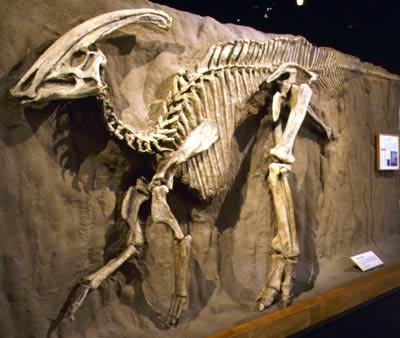Duckbill Dinosaurs Sound
Homepage > Dinosaur Anatomy - Dinosaur
Sounds
Most reptiles alive today are silent, but dinosaurs may have communicated with other members. This belief is supported by the dinosaurs' skull anatomy, which suggests that they were capable of producing sounds to communicate. This ability is mainly seen on large herding herbivores such as Parasaurolophus. The ability to communicate with others may have been a valuable aid for survival. The sounds produced by these dinosaurs may have been useful to ward off predators or warn other members of the herd about an imminent attack. Other uses may have included courtship calls to attract mates.
 The
crest of Parasaurolophus was hollow. Air passages were created through
its crest. They commenced at the nostrils and looped down to connect to
the back of the throat. The crest was part of the dinosaur's nasal cavity
moved on top of its head. Parasaurolophus' crest acted as a natural resonating
chamber.
The
crest of Parasaurolophus was hollow. Air passages were created through
its crest. They commenced at the nostrils and looped down to connect to
the back of the throat. The crest was part of the dinosaur's nasal cavity
moved on top of its head. Parasaurolophus' crest acted as a natural resonating
chamber.
This chamber was 8 feet in length in adults and was capable of creating low resonating sounds that could be heard from long distances. These sounds may have been too low for a human to hear.
Interesting Fact [When Parasaurolophus was first discovered, paleontologists thought its crest was used underwater, perhaps as a snorkel.]
